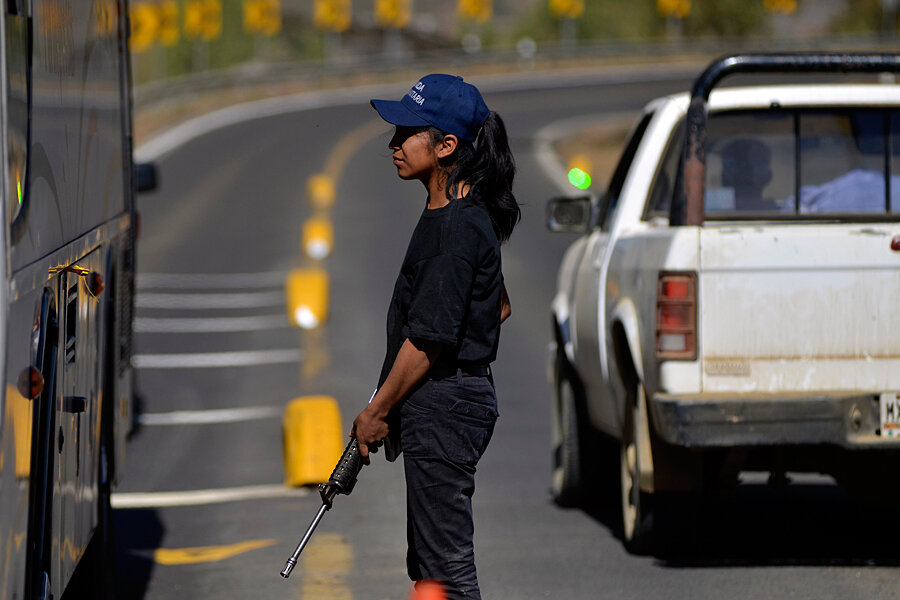Why land rights may hold key to curbing drug smuggling in Central America
Loading...
| San José, Costa Rica
Governments in Central America rely on speedboats, surveillance planes, and militarized police forces to fight drug trafficking that has ravaged the isthmus in recent years. But a low-tech solution might offer another way to prevent smugglers: bolstering indigenous land rights.
New research by the El Salvador-based policy research nonprofit PRISMA presented here this week found that well-organized forest communities in Mexico and Central America have successfully defended their land from incursions by criminal gangs who cut down forests for airstrips and convert land for side projects.
Greater recognition of indigenous land rights can motivate communities to manage their forests – including sustainable logging, eco-tourism, and payment for environmental services like carbon dioxide capture – and help deter the expansion of drug trafficking into protected areas, the study found.
Since the mid-2000s, Central America has emerged as an important trafficking corridor after an uptick in maritime interdiction pushed cartels toward overland travel. The US State Department estimates that 86 percent of the cocaine sold in the US, the world’s largest cocaine market, transits Central America. And as Latin American leaders from Uruguay to Colombia to Mexico rethink the US-led war on drugs and its militarized approach, less showy strategies like recognizing indigenous land rights could get more play.
"When governments support the rights of indigenous peoples and forest communities and give them solid ground on which to defend and manage their forests…they can be more effective," says Andrew Davis, senior researcher with PRISMA and co-author of the report, entitled “Indigenous and Rural Communities Defending Land Rights: Case Studies on Prevention and Defensive Experiences against Drug Trafficking and Organized Crime in Mesoamerica.”
"It's like a giant neighborhood watch program. Even if you're not officially part of one of the patrols you're part of a community. If someone comes in, you know what to do, who to contact to make sure that person is not entering without authorization,” says Mr. Davis.
'Alternatives'
Many governments in the region have state-run conservation programs, but park rangers are often ill equipped to adequately protect forests in their care, Davis says. The PRISMA report points to reduced rates of deforestation in the Maya Biosphere Reserve in Petén, Guatemala, as a successful example of community involvement. Compared to areas managed by park authorities, indigenous-managed concessions saw three times less deforestation and lower levels of organized crime.
Drug traffickers clearcut forests in remote protected land to build airstrips; land is also converted for logging, cattle ranching, and cash crops to launder profits. Forest communities are also being displaced by state-sponsored dams and mines.
Communities that have a long-term interest in the forest’s wellbeing can sustainably use the woodland’s resources to improve their livelihoods. A stronger local economy could deter young people from getting involved in the illicit drug trade, says Davis.
Elected leader of the Panama-based Emberá Wounaan people, Cándido Mezúa, agrees. "The question that worries us more than security is how to generate alternatives that keep our young people from falling into drugs,” Mr. Mezúa says. “This is where forest management becomes a very positive alternative for our community's development."
But giving indigenous communities control over protected lands may not be enough, says Laura Carlsen, Americas program director for the Center for International Policy. She warns that trust needs to develop between authorities and forest communities for such cooperation to flourish.
In 2011, in the largely indigenous town of Cherán, Michoacán in Mexico, for example, the community came together to kick out drug traffickers – and the police, who were blamed for not curbing illegal logging in the area.
Communities physically ejecting drug traffickers “is a last resort that puts people at great risk,” Ms. Carlsen says. “It's not something to consider as a best practice.”
Mezúa says indigenous communities need to be more involved with state security decisions when it comes to patrolling protected land. These decisions should also respect indigenous land rights and customs, he says.







